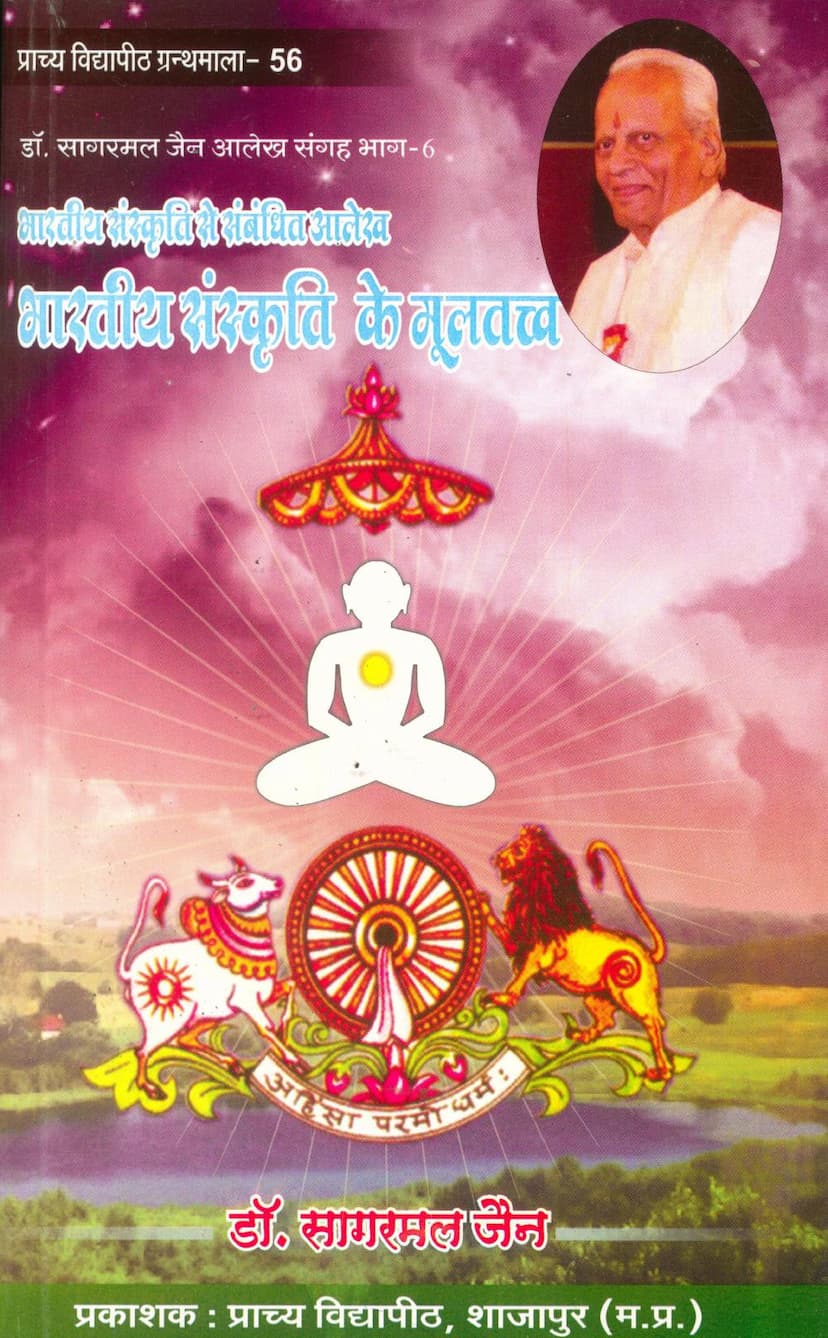Bharatiya Sanskruti Ke Multattva Sambandhit Aalekh
Added to library: September 1, 2025

Summary
This document is the table of contents and initial pages of "Bharatiya Sanskruti ke Mul-Tattva Sambandhit Aalekh" (Essays Related to the Fundamental Elements of Indian Culture), a collection of writings by Dr. Sagarmal Jain, published by Prachya Vidyapith, Shajapur.
The book is part of the Prachya Vidyapith Granthamala series (Volume 56) and is specifically "Sagarmal Jain Aalekh Sangrah Bhag-6" (Collection of Dr. Sagarmal Jain's Essays, Part 6), focusing on Indian Culture. It was published in 2014-15 and costs ₹200.
The publication is dedicated to four revered Jain ascetics: Shri Vallabhkunverji M.S., Shri Pankunvarji M.S., Shri Hemprabhshriji M.S., and Shri Maniprabhshriji M.S. It is also published in loving memory of the author's wife, late Smt. Kamalabai Jain.
The table of contents reveals the thematic focus of this volume, which is to explore the fundamental aspects of Indian culture. The essays cover a range of topics related to Indian civilization and its core principles, particularly from a Jain perspective. Some of the key topics addressed in the essays include:
- The fundamental elements of Indian culture.
- The life vision of Indian culture.
- The synthesized nature of Indian culture.
- Social consciousness in Indian philosophy.
- Social thought in Indian culture.
- Social equality in Indian culture, with a special focus on the Varna and caste systems.
- The interrelationship between spiritual practice (sadhana) and service in Indian culture.
- The question of self-interest versus public welfare in Indian culture.
- The life values in Indian culture.
- Religious tolerance in Indian culture.
- The essence of religion: The Indian life vision.
- Religious tolerance and Jainism.
- Secularism and Buddhism.
- Hinduism: Religious tolerance and co-existence.
The initial pages delve into the foundational principles of Indian culture, emphasizing the development of a balanced life perspective, the concept of equanimity, and the pursuit of self-reliance. It discusses how an individual's life perspective shapes their development and behavior. The text highlights the Indian philosophical emphasis on right perspective (Samyak-Drishti) as crucial for spiritual growth, referencing Jainism's "Trividh-Sadhana," Buddhism's "Ashtangik Marga," and the Bhagavad Gita's "Yoga Marga."
A significant portion of the early essays focuses on defining the ultimate goal of human life as achieving Samatva (equanimity) and renouncing Mamatva (possessiveness). It explains that Samatva means maintaining a state of mental equilibrium amidst favorable and unfavorable circumstances, free from stress and disturbance. This state is described as the essence of liberation or Nirvana. The text critiques modern materialistic and consumerist cultures for increasing stress and calls for the development of a balanced life perspective as the true goal of Indian culture.
The book also explores the concept of self-sovereignty (Atm-Svatantrya), distinguishing it from license (Swachhandata), and emphasizing that true freedom lies in ethical conduct and righteousness. It asserts that dependence on others is a form of bondage, and even dependence on a higher power is considered a limitation. The ultimate liberation, according to Jain philosophy, is the attainment of the divine state within oneself.
The initial essays also touch upon the importance of Ahimsa (non-violence), defining it not just as the absence of violence but as a comprehensive principle of respecting life in all its forms. It discusses the psychological basis of Ahimsa, rooted in mutual fearlessness and trust, and criticizes the Western philosophical notion of Ahimsa being based on fear.
Furthermore, the book emphasizes the principle of respect for others' ideologies and faiths, drawing from Jainism's concept of Anekantavada (non-absolutism). It argues that knowledge is limited and relative, and therefore, no one has the right to dismiss others' beliefs as entirely false. The text promotes a tolerant outlook, recognizing the possibility of truth in differing viewpoints.
The concept of detachment while remaining duty-bound is also explored, highlighting attachment (Asakti) or craving (Trishna) as the root cause of suffering. It discusses how possessiveness (Mamatva) leads to desires, expectations, and ultimately, stress and societal disharmony.
Finally, the collection delves into the synthesized nature of Indian culture, emphasizing the interconnectedness of Jain, Buddhist, and Hindu traditions. It argues that understanding Indian culture requires studying these traditions holistically and recognizing their mutual influences throughout history. The text notes how concepts like Tapas, Sannyasa, Dhyana, Samadhi, Moksha, and Ahimsa integrated into Vedic thought, likely influenced by the Shraman traditions. It points out that Upanishads, Mahabharata, and Gita represent a synthesis of Vedic and Shraman streams, redefining Vedic rituals in a more spiritual light.
In essence, the book "Bharatiya Sanskruti ke Mul-Tattva Sambandhit Aalekh" by Dr. Sagarmal Jain offers a deep dive into the philosophical, social, and ethical underpinnings of Indian culture, with a particular emphasis on Jain perspectives, advocating for tolerance, equanimity, self-reliance, and holistic well-being.